
You are here
Hill’s Pet Nutrition Center-The Tour, Part Two
[if you missed part one, you can read it HERE]
The agenda for the rest of the day included presentations about Hill’s Philosophy of Precisely Balanced Nutrition and about their Promise of Quality & Safety.
Hill’s has 170 different products for dogs and cats that are divided into two distinct lines: “Science Diet®” and “Prescription Diet®” (which is only available through a Vet). Does that blow your mind, too? Does it seem like a bit much? Sure there are different nutritional requirements for a kitten than for a senior cat and for a dog who’s a couch potato versus a dog who does agility training, but do consumers really need to choose from 170 different products?
I had to take a deep breath. Does it make sense that there needed to be such clearly defined types of food? There’s food for cats who have kidney problems, cats with thyroid problems, cats who are fat, cats who have skin allergies. There’s wet, there’s dry, there’s more versions of the same for dogs.
But why not take a step back? Treat the underlying cause for these issues. What CAUSED these problems instead of treating them using the same mindset as a pharmaceutical company—don't cure the problem, manage the symptoms and keep the patient comfortable.
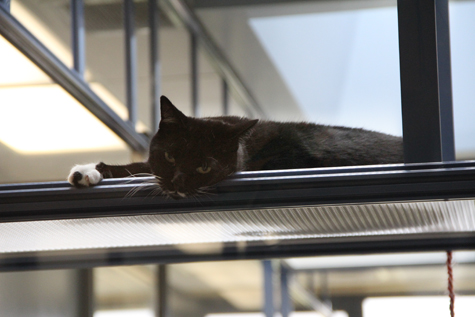
©2012 Hill's. Black cat in group home. (used with permission)
From my standpoint, there really only needs to be one wholesome food that branches out to a variety of single, unique proteins with slight tweaks of additional ingredients you can rotate feeding. That way the cat or dog doesn’t get bored and it ensures the animal gets a balanced diet since some proteins are higher in fat or other vitamins and minerals and some are lower in differing ratios. Rotating the proteins, again, just common sense (and yes there are Vets who support this notion as well).
My father, who was a microbiologist and in charge of Quality Assurance for a major corporation in the dairy industry always said this to me about proper nutrition; “Everything in moderation.”
If I was going to get on board with the need for a growing number of different foods, then I would be very impressed with how Hill’s goes about creating them. They do palatability tests. They have humans learn to sniff out different flavors, then do testing on those flavor combinations to see what goes over well with a cat versus a dog. They have the ability to “map” out flavor combinations and create charts that show what cats prefer versus dogs. Turns out cats love grassy scent, but not earthy. They like fish, but not if it’s too fishy. They have teams of people who just work on the science of taste. That was quite impressive, but is it really necessary?
They’re also very serious about food safety and have extremely strict protocols for each and every ingredient they purchase, strict guidelines their vendors must attain and everything is tested before it even ENTERS their manufacturing plants in the US and eastern Europe.
What we didn’t get to learn about was Hill’s nutrigenomics because their lead person had left the company recently. We saw a chart while walking in the hallway and a tech from that department told us how they take the DNA from a cat or dog and have ways of seeing how it reacts when specific nutrients are applied to it. From their web site it states: “For Hill's, nutrigenomics is promoting lifelong health through targeted nutrition. We strategically formulate our pet foods to address the genetic processes that help keep our pets healthy and promote longevity. Nutrigenomics is not to be confused with just making food targeted to a pet's breed…
_Jane_Victoria(shelf).jpg)
©2012 Hill's. Christina Scott with Mauer and Jane Victoria(on shelf). (used with permission)
… One of our therapeutic weight control pet foods, Hill's® Prescription Diet® r/d® Canine, is another example of our use of nutrigenomics technology. The nutrition in Prescription Diet® r/d® Canine features targeted nutrients that support healthy metabolism, thereby helping dogs burn fat more efficiently.”
This is where my head started to spin. Wouldn't a wholesome diet help an animal burn fat appropriately? My concern here is that by affecting the metabolism so that it “burns fat more efficiently,” what does that do long-term to the animal? Is it as simple as helping dogs burn off fat? What if this changes the dog's metabolism permanently, even after this Prescription Diet® r/d® food is no longer fed? There may be a tipping point in the life of that dog where fat burning becomes a problem, not a solution.
I asked about the length of clinical food testing trials they do on the animals in their care. The trials last no more than 6 months and are done on a handful of animals, with one exception where they followed a group of dogs that lived as the single pet with a family for 5 years.
I can’t agree that six months is a long enough time to see the effects a specific diet will have on an animal especially when you realize that consumers will potentially feed their pets this food for years.
How can you know what a food will do to a cat’s teeth when they do dental cleanings on ALL animals EVERY year? No pet guardian does that in “real life.” How can you know your dry food doesn’t cause dental problems or cause obesity if they only get it for 6 months or, if they get so many other foods to test, how can you say what causes that animal to gain weight? Which food gave the cat diabetes if they’d been tested on 10 or more over the past number of years?
---------------------------------------------

©2012 Hill's. Dr. Stone and HotBot with exercise pen in background. (used with permission)
We had a very interesting presentation by Dr. Bill Schoenherr, the Principal Nutritionist at Hill’s, who has a long background in the cattle feed industry and more recently in the pet food industry. He talked about how to read a pet food label and the AAFCO (Association of American Feed Control Officials) guidelines for food ingredients that AAFCO approved manufacturers must follow. Each and every ingredient is listed as to what it can be and cannot be, what form it should take, from what part of the animal or plant and so on. You have to be a member of the Federation of Animal Science Societies to purchase a copy of the AAFCO guidelines that were last updated in 2008.
How to read a pet food label could easily be book in and of itself, but some of the big things you should know are that ingredients are listed by weight-heaviest weight is listed first. If the food lists “chicken” first, it’s no different than the AAFCO definition of “chicken meal” (which certainly sounds worse than just Chicken to consumers). “Meal” is the dry form of chicken. It’s nutritionally similar, it weighs less and is cheaper and easier to ship, but consumers see the word “chicken” and assume it’s the same as what they would eat. WRONG!
 copy.jpg)
©2012 Hill's. Dr. Burris with Hug Me Jeff and Fraizer. (used with permission)
The chicken our pets get is not very appetizing. It’s no feathers, heads or feet (feet are in by-products), but it’s not organs or much muscle meat. It’s a lot of bones and the ash content can differ by supplier.
He spoke a lot about food descriptors like, “gravy, dinner, platter, entrée, formula.” What he didn’t talk about was what sort of goal Hill’s had regarding these ingredients or descriptors. It was said over and over again their only goal was “complete and balanced diet,” but they didn’t say how they made that happen for obligate carnivores using ingredients like corn, wheat, soy or cellulose in foods that were often over-cooked to the point of a breakdown in nutrients.
---------------------------------------------
I was disappointed by the presentation by Dr. Julie Churchill who is a Vet Nutritionist at the University of Minnesota. Her presentation was about nutritional assessment of dogs. She started by saying to the effect that she was not being paid by Hill’s to say what was on her mind about nutrition, and that she hoped they would invite her back again, suggesting she was about to say something mind-blowing about animal nutrition. Silently, I was rooting her on, hoping she’d say the “R” (raw) word.
In fact, all she did was talk about scoring a cat or dog’s physical condition and that optimal nutrition was the cornerstone of good health—DUH. Her presentation featured images from the AAHA’s (The American Animal Hospital Association) web site regarding a study that was paid for by Hill’s. I kept waiting for her to say something about what makes up optimal nutrition, not just that an animal needs it, but what IS it?
I didn’t have the nerve to say something in public but as we began the tour of the facility, I asked her what makes up optimal nutrition and she wouldn’t answer me directly, only saying it was a good question.
Animal Testing
Our tour included seeing the housing for Hill’s “Pet Partners” (research animals)—420 dogs and 500 cats. Their facility is 40,000 square feet. We saw about one half of it. They mostly house beagles from known breeders and domestic short-haired cats, again from breeders or they breed them in-house. They also take animals from other labs when their tests are completed. They’re too concerned about bringing illness into their facility by rescuing shelter cats or dogs to get animals from those places.
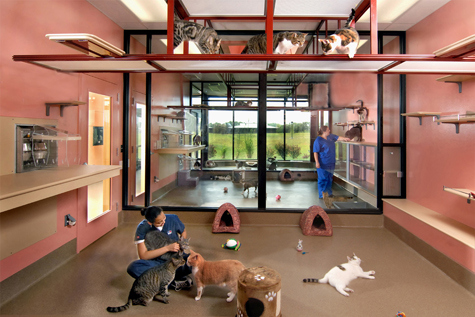
©2012 Hill's. One of the many group homes. (used with permission)
The animals are in group homes with spotless platforms to lie on, big windows and plenty of space to move around. We were not allowed to take photos of these areas, but were provided a few by Hill's.
The dogs have outdoor access and they have 2-hour breaks outside, then are rotated inside so another group can go outside.
There are 65 people caring for over 900 animals.
Anyone who works at Hill’s can take a dog for a walk or work on their computer and hang out with certain cats. The cats get new toys weekly and have a few rather scant cat trees and soft places to rest.
As we walked near the glass walled enclosures for the cats, some of them ran over to rub up against the glass. Everyone cooed over their actions, but I felt sad. The cats and the dogs are supposed to get enrichment, which includes time with humans, but how can they ever give them enough? I saw a staff member enter a room and all the cats got up and ran over to her, desperate for attention. The cats would live there for lifetime, with an exceptional few who can be adopted into a home when they’re too old to be tested. I wanted to scoop them up and get them out of there. It’s hard to see animals who clearly need love, not be able to get enough of it. I understand that the people at Hill’s do their very best to provide for these animals, but in the end, it’s difficult to imagine how 65 people give 900 animals enough love and attention.

©2012 Hill's. Daphne. (used with permission)
I asked about what happens when a cat gets too old to be tested or develops health problems where they can no longer provide good test results...
…find out in my final post tomorrow.


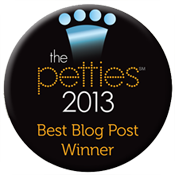
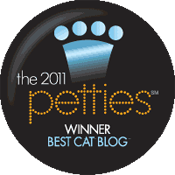

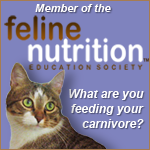







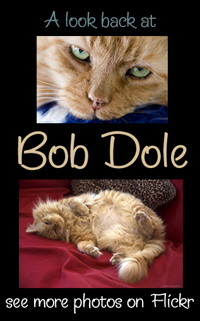

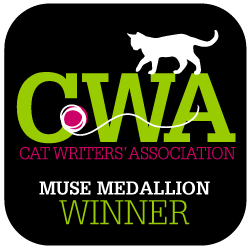
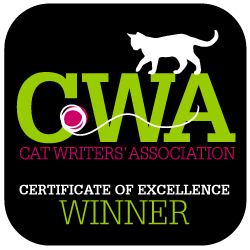

Comments
I found a lot of their
I found a lot of their answers to mirror answers given by politicians.. Round and circular logic until they got back around to the points they wanted you to take.
hills
Interesting...and sad. I used to feed Science Diet..they had so many to chose from so I did a search to figure out which SD was the best..and my search lead me to healthier brands..and SD was not even listed..I threw out their SD and started feeding no grain, soft food..
I will keep my commets to myself, but I really do not like Hills.
After much research, I have
After much research, I have chosen to NEVER feed my cats Hill's. It's horrible stuff and not made for carnivores. Instead, they get a grain-free moist diet.
Dry food is the ultimate in horrible food. Cats don't have the thirst drive humans and dogs have. In the wild, they depend on their kill for hydration.
FWIW, Hill's (prescription) food bound my daughter's dog up so much that he died within 30 minutes of finally being able to have a bowel movement. The pile was the size a horse would make and he was just a 60 pound English Bulldog. :(
They never answer that question
I took their nutrition class for work. They talk about optimal health but never define it. They go through a bunch of labels of how there's not specific definitions of holistic or natural or wholesome etc. - lots of marketing stuff. They talk about how their corn is mealed and not whole corn so it is digestible and it is the fat that matters for energy and stuff. They say grain free is the new buzz word and that just because a food is grain free doesn't mean it is healthy (there's a point there - potatos and peas are carbs too, but that means they can put the coveted grain free label on the Ideal Balance line). And they say it has never been proven that cats can't do well on carbs. Raw never ever ever gets mentioned.
I was under the impression from the class that chicken did mean chicken - as in muscle meat, but that meal could be bones? I could have misunderstood, but I did think chicken meant chicken, and meal was cooked, dried and mealed chicken parts.
It is so confusing as a pet parent - never mind a retailer trying to educate customers in the 5 minutes or less before they lose interest. And doing it without upsetting any of the reps of any of the product lines the store carries. (Hills is one - but we also carry three commercial raw brands in our store and 4 company wide.)
Things that make you go hmmmmmm.....
My vet has suggested hills c/d because our Bengal had crystals, and it was something we could feed our 'girls' without making her sister Aby ill. I have been stalling and dragging my feet on the change due to I want to stay away from grains. Since we travel between the US & Canada twice a week with them to vacation property, it makes a raw diet impossible, but now more than ever, I am questioning the cd, or perhaps it was s/d. I can't remember which prescription diet she was on, and what was the long term food suggestion is.
I know that animal testing is important, and I do support it, but I don't support the end of life decisions on these little gremlins, when their test life is over, why can't they continue to live in a happy retirement home, with a family, so that for even a brief period of their lives, they know unconditional love. There are seniors homes and hospice homes that take in animals to comfort their residents.. to me, this would be a win win situation, for pets who's lives may not be so long
Add new comment